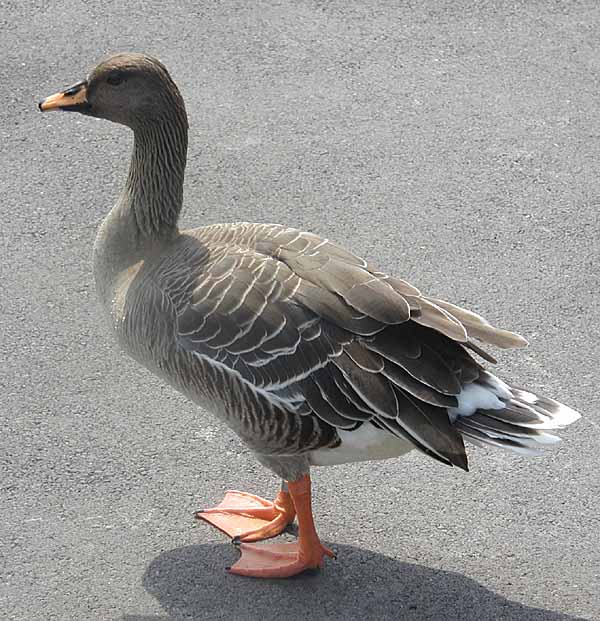- Bean Goose
__NOTOC__Taxobox
name = Bean Goose
status = LC | status_system = IUCN3.1

image_width = 240px
regnum =Animal ia
phylum = Chordata
classis = Aves
ordo =Anseriformes
familia =Anatidae
genus = "Anser"
genus_authority =Brisson , 1760
subdivision_ranks = Species
subdivision = Taiga Bean-Goose "Anser fabalis"
Tundra Bean-Goose "Anser serrirostris"The Bean Goose is a medium to large
goose breeding in northernEurope andAsia . It has been split into two species by the AOU (2007) and the BOU (year?)--see below. It is migratory and winters further south in Europe and Asia.The length ranges from 68 to 90 cm (27-36 in), wingspan from 140 to 174 cm (55-69 in) and weight from 1.7-4 kg (3.7-8.8 lbs). The bill is black at the base and tip, with an orange band across the middle; the legs and feet are also bright orange.
The upper wing-coverts are dark brown, as in the
White-fronted Goose ("Anser albifrons") and theLesser White-fronted Goose ("A. erythropus"), but differing from these in having narrow white fringes to the feathers.Its English and scientific names come from its habit in the past of grazing in
bean field stubbles in winter (Latin "faba", a bean).There are five
subspecies , with complex variation in body size and bill size and pattern; generally, size increases from north to south and from west to east. Some ornithologists (including AOU 2007) split them into two species based on breeding habitat, whether in forest bogs in the subarctictaiga , or on thearctic tundra . ;Taiga Bean Goose ("Anser fabalis" sensu stricto)
* "A. f. fabalis". Scandinavia east to the Urals. Large; bill long and narrow, with broad orange band. "Anser fabalis fabalis" is one of the species to which the "Agreement on the Conservation of African-Eurasian Migratory Waterbirds" (AEWA ) applies.
* "A. f. johanseni". West Siberian taiga. Large; bill long and narrow, with narrow orange band.
* "A. f. middendorffii". East Siberian taiga. Very large; bill long and stout, with narrow orange band.;Tundra Bean Goose ("Anser serrirostris", if treated as a distinct species)
* "A. s. rossicus". Northern Russian tundra east to the Taimyr Peninsula. Small; bill short and stubby, with narrow orange band. "Anser fabalis rossicus" is one of the species to which the "Agreement on the Conservation of African-Eurasian Migratory Waterbirds" (AEWA ) applies.
* "A. s. serrirostris". East Siberian tundra. Large; bill long and stout, with narrow orange band.The voice is a loud honking, higher pitched in the smaller subspecies.
The closely related
Pink-footed Goose ("A. brachyrhynchus") has the bill short, bright pink in the middle, and the feet also pink, the upper wing-coverts being nearly of the same bluish-grey as in theGreylag Goose . In size and bill structure, it is very similar to "Anser fabalis rossicus", and in the past was often treated as a sixth subspecies of Bean Goose.tatus in Britain
The Bean Goose is a rare winter visitor to Britain. There are two regular wintering flocks of Taiga Bean Goose, in the
Yare Valley ,Norfolk and the Avon Valley,Scotland . A formerly regular flock inDumfries and Galloway no longer occurs there. Tundra Bean Goose has no regular wintering sites, but is found in small groups among othergrey goose species - among the most regular locaities areWWT Slimbridge ,Gloucestershire andHolkham Marshes ,Norfolk .Photo Image links
* [http://cyberbirding.uib.no/photo/a_fabalis_01.php Cyberbirding: Bean Goose pictures]
References
* Database entry includes justification for why this species is of least concern
* Sangster, George andGerald J. Oreel (1996) Progress in taxonomy of Taiga and Tundra Bean Geese "Dutch Birding " 18(6): 310-316External links
* [http://www.rspb.org.uk/birds/guide/b/beangoose/index.asp RSPB Bean Goose Page]
* [http://www.birdguides.com/html/vidlib/species/Anser_fabalis.htm Birdguides Bean Goose Page]
Wikimedia Foundation. 2010.
